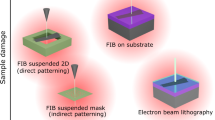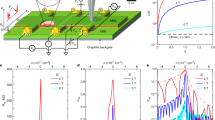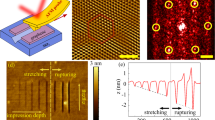Abstract
In an all-van der Waals heterostructure, the active layer, gate dielectrics and gate electrodes are assembled from two-dimensional crystals that have a low density of atomic defects. This design allows two-dimensional electron systems with very low disorder to be created, particularly in heterostructures where the active layer also has intrinsically low disorder, such as crystalline graphene layers or metal dichalcogenide heterobilayers. A key missing ingredient has been nanoscale electrostatic control, with existing methods for fabricated local gates typically introducing unwanted contamination. Here we describe a resist-free local anodic oxidation process for patterning sub-100 nm features in graphite gates, and their subsequent integration into an all-van der Waals heterostructure. We define a quantum point contact in the fractional quantum Hall regime as a benchmark device and observe signatures of chiral Luttinger liquid behaviour, indicating an absence of extrinsic scattering centres in the vicinity of the point contact. In the integer quantum Hall regime, we demonstrate in situ control of the edge confinement potential, a key requirement for the precision control of chiral edge states. This technique may enable the fabrication of devices capable of single anyon control and coherent edge-state interferometry in the fractional quantum Hall regime.
This is a preview of subscription content, access via your institution
Access options
Access Nature and 54 other Nature Portfolio journals
Get Nature+, our best-value online-access subscription
$29.99 / 30 days
cancel any time
Subscribe to this journal
Receive 12 print issues and online access
$209.00 per year
only $17.42 per issue
Buy this article
- Purchase on Springer Link
- Instant access to full article PDF
Prices may be subject to local taxes which are calculated during checkout




Similar content being viewed by others
Data availability
The data that support the findings of this study are available via Zenodo at https://doi.org/10.5281/zenodo.7916266. Source data are provided with this paper.
References
Zibrov, A. A. et al. Tunable interacting composite fermion phases in a half-filled bilayer-graphene Landau level. Nature 549, 360–364 (2017).
Li, J. I. A. et al. Even denominator fractional quantum Hall states in bilayer graphene. Science 358, 648–652 (2017).
Dean, C., Kim, P., Li, J. I. A. & Young, A. Fractional quantum Hall effects in graphene. in Fractional Quantum Hall Effects: New Developments 317–375 (World Scientific, 2020).
Li, J. I. A., Taniguchi, T., Watanabe, K., Hone, J. & Dean, C. R. Excitonic superfluid phase in double bilayer graphene. Nat. Phys. 13, 751–755 (2017).
Liu, X., Watanabe, K., Taniguchi, T., Halperin, B. I. & Kim, P. Quantum Hall drag of exciton condensate in graphene. Nat. Phys. 13, 746–750 (2017).
Ma, L. et al. Strongly correlated excitonic insulator in atomic double layers. Nature 598, 585–589 (2021).
Serlin, M. et al. Intrinsic quantized anomalous Hall effect in a moiré heterostructure. Science 367, 900–903 (2020).
Li, T. et al. Quantum anomalous Hall effect from intertwined moiré bands. Nature 600, 641–646 (2021).
Spanton, E. M. et al. Observation of fractional Chern insulators in a van der Waals heterostructure. Science 360, 62–66 (2018).
Xie, Y. et al. Fractional Chern insulators in magic-angle twisted bilayer graphene. Nature 600, 439–443 (2021).
Cao, Y. et al. Unconventional superconductivity in magic-angle graphene superlattices. Nature 556, 43–50 (2018).
Yankowitz, M. et al. Tuning superconductivity in twisted bilayer graphene. Science 363, 1059–1064 (2019).
Zhou, H., Xie, T., Taniguchi, T., Watanabe, K. & Young, A. F. Superconductivity in rhombohedral trilayer graphene. Nature 598, 434–438 (2021).
Zhou, H. et al. Isospin magnetism and spin-polarized superconductivity in Bernal bilayer graphene. Science 375, 774–778 (2022).
Zhang, Y. et al. Enhanced superconductivity in spin–orbit proximitized bilayer graphene. Nature 613, 268–273 (2023).
Dean, C. R. et al. Boron nitride substrates for high-quality graphene electronics. Nat. Nanotechnol. 5, 722–726 (2010).
Young, A. F. et al. Electronic compressibility of layer-polarized bilayer graphene. Phys. Rev. B 85, 235458 (2012).
Mayorov, A. S. et al. Micrometer-scale ballistic transport in encapsulated graphene at room temperature. Nano Lett. 11, 2396–2399 (2011).
Wang, L. et al. One-dimensional electrical contact to a two-dimensional material. Science 342, 614–617 (2013).
Haigh, S. J. et al. Cross-sectional imaging of individual layers and buried interfaces of graphene-based heterostructures and superlattices. Nat. Mater. 11, 764–767 (2012).
Ronen, Y. et al. Aharonov–Bohm effect in graphene-based Fabry–Pérot quantum Hall interferometers. Nat. Nanotechnol. 16, 563–569 (2021).
Zimmermann, K. et al. Tunable transmission of quantum Hall edge channels with full degeneracy lifting in split-gated graphene devices. Nat. Commun. 8, 14983 (2017).
Déprez, C. et al. A tunable Fabry–Pérot quantum Hall interferometer in graphene. Nat. Nanotechnol. 16, 555–562 (2021).
Zhao, L. et al. Graphene-based quantum Hall interferometer with self-aligned side gates. Nano Lett. 22, 9645–9651 (2022).
Li, H. et al. Electrode-free anodic oxidation nanolithography of low-dimensional materials. Nano Lett. 18, 8011–8015 (2018).
Novoselov, K. S., Mishchenko, A., Carvalho, A. & Neto, A. H. C. 2D materials and van der Waals heterostructures. Science 353, aac9439 (2016).
Masubuchi, S., Ono, M., Yoshida, K., Hirakawa, K. & Machida, T. Fabrication of graphene nanoribbon by local anodic oxidation lithography using atomic force microscope. Appl. Phys. Lett. 94, 082107 (2009).
Butt, H.-J., Farshchi-Tabrizi, M. & Kappl, M. Using capillary forces to determine the geometry of nanocontacts. J. Appl. Phys. 100, 024312 (2006).
van Wees, B. J. et al. Quantized conductance of point contacts in a two-dimensional electron gas. Phys. Rev. Lett. 60, 848–850 (1988).
Datta, S. Electronic Transport in Mesoscopic Systems (Cambridge Univ. Press, 1995).
Milliken, F. P., Umbach, C. P. & Webb, R. A. Indications of a Luttinger liquid in the fractional quantum Hall regime. Solid State Commun. 97, 309–313 (1996).
Radu, I. P. et al. Quasi-particle properties from tunneling in the ν = 5/2 fractional quantum Hall state. Science 320, 899–902 (2008).
Baer, S. et al. Interplay of fractional quantum Hall states and localization in quantum point contacts. Phys. Rev. B 89, 085424 (2014).
Johnson, M. D. & MacDonald, A. H. Composite edges in the ν=2/3 fractional quantum Hall effect. Phys. Rev. Lett. 67, 2060–2063 (1991).
Kane, C. L., Fisher, M. P. A. & Polchinski, J. Randomness at the edge: theory of quantum Hall transport at filling ν=2/3. Phys. Rev. Lett. 72, 4129–4132 (1994).
Nakamura, J., Liang, S., Gardner, G. C. & Manfra, M. J. Half-integer conductance plateau at the ν = 2/3 fractional quantum Hall state in a quantum point contact. Phys. Rev. Lett. 130, 076205 (2023).
Sabo, R. et al. Edge reconstruction in fractional quantum Hall states. Nat. Phys. 13, 491–496 (2017).
Chamon, Cd. C. & Wen, X. G. Sharp and smooth boundaries of quantum Hall liquids. Phys. Rev. B 49, 8227–8241 (1994).
Wang, J., Meir, Y. & Gefen, Y. Edge reconstruction in the ν = 2/3 fractional quantum Hall state. Phys. Rev. Lett. 111, 246803 (2013).
Meir, Y. Composite edge states in the ν=2/3 fractional quantum Hall regime. Phys. Rev. Lett. 72, 2624–2627 (1994).
Kane, C. L. & Fisher, M. P. A. Edge-state transport. in Perspectives in Quantum Hall Effects 109–159 (John Wiley & Sons, 1996).
Wen, X. G. Chiral Luttinger liquid and the edge excitations in the fractional quantum Hall states. Phys. Rev. B 41, 12838–12844 (1990).
Luttinger, J. M. An exactly soluble model of a many-fermion system. J. Math. Phys. 4, 1154–1162 (1963).
Wen, X.-G. Edge transport properties of the fractional quantum Hall states and weak-impurity scattering of a one-dimensional charge-density wave. Phys. Rev. B 44, 5708–5719 (1991).
Roddaro, S. et al. Nonlinear quasiparticle tunneling between fractional quantum Hall edges. Phys. Rev. Lett. 90, 046805 (2003).
Baer, S. et al. Experimental probe of topological orders and edge excitations in the second Landau level. Phys. Rev. B 90, 075403 (2014).
Chang, A. M., Pfeiffer, L. N. & West, K. W. Observation of chiral Luttinger behavior in electron tunneling into fractional quantum Hall edges. Phys. Rev. Lett. 77, 2538–2541 (1996).
Chang, A. M., Wu, M. K., Chi, C. C., Pfeiffer, L. N. & West, K. W. Plateau behavior in the chiral Luttinger liquid exponent. Phys. Rev. Lett. 86, 143–146 (2001).
Banerjee, M. et al. Observation of half-integer thermal Hall conductance. Nature 559, 205–210 (2018).
Banerjee, M. et al. Observed quantization of anyonic heat flow. Nature 545, 75–79 (2017).
Nakamura, J., Liang, S., Gardner, G. C. & Manfra, M. J. Direct observation of anyonic braiding statistics. Nat. Phys. 16, 931–936 (2020).
Abbas, A. Nanofabrication Using Electron Beam Lithography: Novel Resist and Applications. MASc thesis, Univ. of Waterloo (2013).
Saito, Y., Ge, J., Watanabe, K., Taniguchi, T. & Young, A. F. Independent superconductors and correlated insulators in twisted bilayer graphene. Nat. Phys. 16, 926–930 (2020).
Laturia, A., Van de Put, M. L. & Vandenberghe, W. G. Dielectric properties of hexagonal boron nitride and transition metal dichalcogenides: from monolayer to bulk. npj 2D Mater. Appl. 2, 6 (2018).
Acknowledgements
We thank J. Folk and A. Potts for comments on the manuscript, and C. R. Dean and J. Swan for advice on humidity stabilization. We additionally acknowledge Y. Choi for providing the AFM topographs of quantum dot arrays. Work at University of California, Santa Barbara, was primarily supported by the Air Force Office of Scientific Research under award FA9550-20-1-0208 and by the Gordon and Betty Moore Foundation EPIQS program under award GBMF9471. This work used facilities supported via the University of California, Santa Barbara, NSF Quantum Foundry funded via the Q-AMASE-i program under award DMR-1906325. L.A.C. and N.L.S. received additional support from the Army Research Office under award W911NF20-1-0082. T.W. and M.P.Z. were supported by the Director, Office of Science, Office of Basic Energy Sciences, Materials Sciences and Engineering Division, of the US Department of Energy under contract no. DE-AC02-05-CH11231 (van der Waals heterostructures program, KCWF16). K.K. was supported by the US Department of Energy, Office of Science, National Quantum Information Science Research Centers, Quantum Science Center. C.C.R. was supported by the National Science Foundation through Enabling Quantum Leap: Convergent Accelerated Discovery Foundries for Quantum Materials Science, Engineering and Information (Q-AMASE-i) award no. DMR-1906325. K.W. and T.T. acknowledge support from JSPS KAKENHI (grant nos. 19H05790, 20H00354 and 21H05233).
Author information
Authors and Affiliations
Contributions
L.A.C. and A.F.Y. conceived the experiment. L.A.C. and N.L.S. fabricated the devices and performed the measurements. L.A.C., N.L.S., M.P.Z., T.W., K.K. and A.F.Y. analysed the data and wrote the paper. M.P.Z. and S.V. proposed the simulation methodology. T.W., K.K. and C.C.R. performed the numerical calculations based on the proposed theoretical modelling. T.T. and K.W. synthesized the hBN crystals
Corresponding author
Ethics declarations
Competing interests
The authors declare no competing interests.
Peer review
Peer review information
Nature Physics thanks the anonymous reviewers for their contribution to the peer review of this work
Additional information
Publisher’s note Springer Nature remains neutral with regard to jurisdictional claims in published maps and institutional affiliations.
Extended data
Extended Data Fig. 1 Precise determination of α and Hall conductance at B = 6T and B = 13T.
(a) Longitudinal and Hall conductance in the W region of the device for two values of the bottom gate, VB = 1.0V and VB = 2.0V, at B = 10T. All other regions are set to ν = 0. (b) Calculated shift ΔVW applied to the VB = 1.0V trace shows overlap of identical features between the two traces. (c) The region of vanishing longitudinal conductance in ν = − 2/3 was used to numerically determine the shift ΔVW by minimizing the sum of the norm-squared differences between the two traces over a region around ν = − 2/3. (d) σxx and σxy versus VW at B = 13T and VB = 1V. (e) 1/Rxy measured on the west side of the device versus VW while νN = νS = νE = 0 is kept fixed, and VB = − 0.33V. Inset: current measured during 1/Rxy sweep showing ν = 0 gap.
Extended Data Fig. 2 Possible edge structures in ν = − 5/3.
(a) Hole-conjugate FQH states such as ∣ν∣ = 2/3, 5/3 states can be modeled by a Laughlin- like FQH state of holes within a bulk integer quantum Hall state, leading to a small strip of increased filling factor around the edge of the sample. This is shown schematically in panels a and c by plotting the filling factor of holes νh ≡ − ν at the boundary between a ν = − 5/3 and ν = − 1 state, where the relevant fractional edges measured in the experiment occur. The MacDonald model34 of the resulting edge structure posits a downstream integer mode at the outermost edge of the sample, as well as an upstream (counter-propagating) fractional mode. (b) In real experiments, the two counter-propagating charged modes are rarely observed, but rather mix through the presence of inter-edge interactions, yielding a single effective charge-2e/3 mode propagating downstream, as well as an upstream charge-neutral mode, as explained by the Kane-Fisher-Polchinski model35. (c) A sufficiently soft confining potential may make it energetically favorable to redistribute the charge in the system and create an additional strip of density νh = 4/3, introducing a set of two additional counter-propagating fractional edge modes: the Meir model40. (d) In a real system, where these modes can also mix, the resulting mode structure may contain two downstream fractional-conductance modes as well as two upstream neutral modes. This scenario is consistent with the observation of multiple fractional conductance steps within the ν = − 5/3 state.
Extended Data Fig. 3 Tunneling conductance in an integer vs. fractional edge.
(a) Plot of the tunneling conductance across an integer conductance step, in the ν = 1 state. In the fully reflecting and fully transmitting limits, the conductance is constant for VDC less than about – 1 mV –, and smoothly varies as the edge is transmitted. (b) For a fractional edge state, the conductance remains highly suppressed even when the edge state is partially transmitted, with a sharply nonlinear dI/dV near VDC = 0. Even when the edge state is fully transmitted, and dI/dV (VDC = 0) = 4/3, the tunneling conductance remains nonlinear. (c) and (d) present linecuts of the data in (a) and (b) respectively for comparison.
Extended Data Fig. 4 Thomas-Fermi simulations of the QPC pinch-off.
(a) The filling at the center of the QPC, νQPC as a function of VB and VNS + αVB, with the bulk filling of the east/west regions fixed at νEW = − 6. The result qualitatively mimics the measured GD shown in Fig. 4a since νQPC determines the number of transmitted modes and therefore the diagonal conductance. Two line cuts which correspond to EV/EC = 2.2 and 4.4 are shown in Fig. 4c. (b-c) Calculated filling factor ν for a realistic device geometry at B = 2 T for (b) EV/EC = 4.4 and (c) EV/EC = 2.2. When EV/EC = 2.2, there exists an incompressible island with νQPC = − 4 at the center of the QPC. Contours of ν = n + 1/2 are shown as white dotted lines, indicating the location of chiral edge modes, two-pairs of which are transmitted through the QPC. This illustrates the rule NQPC = νQPC + 2.
Supplementary information
Supplementary Information
Supplementary Sections 1–5.
Source data
Source Data Fig. 2
Compressed data archive for Fig. 2.
Source Data Fig. 3
Compressed data archive for Fig. 3; the temperature-dependent curves have been collapsed to a single data file for Fig. 3d, simplifying the data format.
Source Data Fig. 4
Compressed data archive for Fig. 4; the simulated data for Fig. 4c have been combined into a single .csv file instead of four .txt files.
Source Data Extended Data Fig. 1
Source data used to generate the linecuts shown in Extended Data Fig. 1, compressed into a single .zip file.
Source Data Extended Data Fig. 3
Source data for Extended Data Fig. 3a,b, from which the linecuts in Extended Data Fig. 3c,d are taken, compressed into a single .zip file.
Rights and permissions
Springer Nature or its licensor (e.g. a society or other partner) holds exclusive rights to this article under a publishing agreement with the author(s) or other rightsholder(s); author self-archiving of the accepted manuscript version of this article is solely governed by the terms of such publishing agreement and applicable law.
About this article
Cite this article
Cohen, L.A., Samuelson, N.L., Wang, T. et al. Nanoscale electrostatic control in ultraclean van der Waals heterostructures by local anodic oxidation of graphite gates. Nat. Phys. 19, 1502–1508 (2023). https://doi.org/10.1038/s41567-023-02114-3
Received:
Accepted:
Published:
Issue Date:
DOI: https://doi.org/10.1038/s41567-023-02114-3



